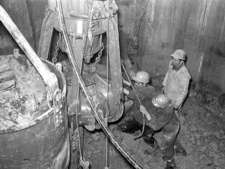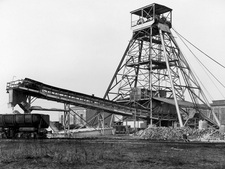History: From iron ore deposit to repository
The Konrad mine has had a changeful history. That the iron ore deposit was discovered at all, was coincidental: When drilling for raw oil, iron ore was found instead of oil.
In the thirties of the last century, a larger iron ore deposit was discovered in a depth of about 660 metres five kilometres south-east of Gifhorn where one was drilling for raw oil. However, it was not until 1957 that Salzgitter Erzbergbau AG initiated the sinking of shaft Konrad 1; shaft 2 was sunk in 1960. Both shafts were connected underground in January 1963 and iron ore was produced from 1965. Altogether 6.7 million tons of ore were mined until 1976. Then ore production was stopped as a result of non-profitability.
Initiative of the works council
It was already known that the mine had to be decommissioned for economic reasons, thus the former works council suggested to the Federation to have it investigated for its suitability to host a repository for radioactive waste. Between 1975 and 1982 the former Gesellschaft für Strahlen- und Umweltforschung (today: Helmholtz Zentrum München) investigated the mine. After these investigations had concluded, the Federal Institute of Science and Metrology (Physikalisch-Technische Bundesanstalt, PTB), at that time responsible for disposal before the Federal Office for Radiation Protection was founded, filed the application for the initiation of a plan-approval (licensing) procedure in 1982.

![]() Still hard work at the beginning of the sixties: Sinking of a shaft
Still hard work at the beginning of the sixties: Sinking of a shaft
Public hearing lasted 75 days
Ten years later the 75-day-lasting public hearing took place. About 290,000 objectors took part in the hearing, apart from the communities of Salzgitter, Braunschweig and Wolfenbüttel and associations such as Greenpeace, Friends of the Earth and some citizens' initiatives. The objections were summarised by the Federal Office for Radiation Protection into 950 topics. In 2002, the Lower Saxon Environment Ministry granted the plan-approval decision (licence).
2007: Legal certainty for Konrad
In 2007, about 30 years after the first pre-investigations and five years after the plan-approval decision, it was confirmed by court decision. The Federal Administrative Court in Leipzig rejected complaints against the non-admission of the revision to the decisions of the Lüneburg Higher Administrative Court. Thus, the Plan can be implemented. The approval of the main operating plan given by the Landesamt für Bergbau, Energie und Geologie Niedersachsen (LBEG) in January 2008 allows for the necessary mining works and is, thus, a necessary step for the conversion of the Konrad mine to a repository for low-level and intermediate-level radioactive waste. The actual repository could only be constructed after this decision had been made. As opposed to Asse or to the Morsleben repository for radioactive waste, the radioactive waste repository is sitting in untouched areas which are not used for commercial mining.
State of 2017.03.30


